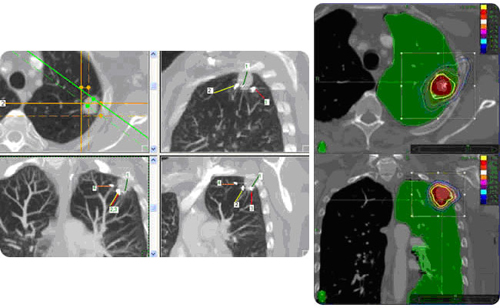Lung cancer is a highly prevalent disease; in 2005 there were an estimated 173,000 new cases in the U.S. alone, with 164,000 deaths. Lung cancer is the leading cause of cancer death in the United States for both men and women, exceeding the combined total deaths from colon, breast, and prostate cancers (the second, third and fourth leading killers). Only 16% of patients present with early or resectable disease that can be treated with curative intent; of these half will survive for five years. Primary surgical resection is the preferred treatment for early stage NSCLC for those patients that can tolerate surgery. For those patients who are medically inoperable, external beam radiotherapy (EBRT), stereotactic body radiotherapy (SBRT) and stereotactic radiosurgery (SRS) are treatment alternatives. Advanced stages of NSCLC are treated by surgery, SRS, SBRT, EBRT, chemotherapy, or a combination of these treatments depending on the extent of disease, the size of the tumor, and the presence of metastasis.
Using the CyberKnife® System to treat lung cancer:
Guidelines for CyberKnife® treatment were based on prior experiences with SBRT in the treatment of patients with medically inoperable NSCLC and those with NSCLC who refused surgery.
The CyberKnife® System is unique in the world of SBRT thanks to its Synchrony® Respiratory Tracking System, which tracks and compensates for tumor movement during treatment delivery. This system was used in a study in which 23 patients received 15 Gy in a single session. There were no grade 3 or higher radiosurgery-related complications. The early tumor response was complete in 2 patients, partial in 15 and stable in 4, with two cases of progressive disease noted.
Non-Small Cell Lung Cancer (T1 N0 M0 stage grouping 1)
(Courtesy St. Joseph's Hospital and Medical Center, Phoenix, AZ)

Multiplanar CT images (Left) show the lung tumor with multiple fiducals positioned in relationship to the ribs, bronchi and other anatomical landmarks. Axial and coronal planning images (right) show CyberKnife®treatment plans. The yellow line corresponds to the 71% prescription isodose.

CyberKnife® treatment rendering (left) Pre-treatment CT (middle) Post-treatment CT (right)
Anterior-posterior 3D rendering (left) shows bony anatomy, segmented lung, and beam orientations and intensities. Pre / Post CyberKnife® treatment image (right): The three 5 mm post-treatment sections on the right (3/7/05), with the 4 fiducials identified, correspond to the twelve 1.25 mm CT pre-treatment slices (11/23/04) in the middle. This comparison shows the radiographically complete response in less than 15 weeks after treatment with some residual fibrosis (top right image)
References
1.Jemal A, Murray T, Ward E, Samuels A, Tiwari RC, Ghafoor A, et al. Cancer statistics, 2005. CA Cancer J Clin 2005;55(1):10-30. PubMed ABSTRACT
2.American Cancer Society. Cancer Facts and Figures 2006. Atlanta: American Cancer Society, 2006. LINK3.Blomgren H, Lax I, Naslund I, Svanstrom R. Stereotactic high dose fraction radiation therapy of extracranial tumors using an accelerator. Clinical experience of the first thirty-one patients. Acta Oncol 1995;34(6):861-70. PubMed ABSTRACT
4.Hara R, Itami J, Kondo T, Aruga T, Uno T, Sasano N, et al. Clinical outcomes of single-fraction stereotactic radiation therapy of lung tumors. Cancer 2006;106(6):1347-52. PubMed ABSTRACT
5.Hof H, Herfarth KK, Munter M, Hoess A, Motsch J, Wannenmacher M, et al. Stereotactic single-dose radiotherapy of stage I non-small-cell lung cancer (NSCLC). Int J Radiat Oncol Biol Phys 2003;56(2):335-41. PubMed ABSTRACT
6.McGarry RC, Papiez L, Williams M, Whitford T, Timmerman RD. Stereotactic body radiation therapy of early-stage non-small-cell lung carcinoma: phase I study. Int J Radiat Oncol Biol Phys 2005;63(4):1010-5. PubMed ABSTRACT
7.Onishi H, Araki T, Shirato H, Nagata Y, Hiraoka M, Gomi K, et al. Stereotactic hypofractionated high-dose irradiation for stage I nonsmall cell lung carcinoma: clinical outcomes in 245 subjects in a Japanese multiinstitutional study. Cancer 2004;101(7):1623-31. PubMed ABSTRACT
8.Timmerman R, Papiez L, McGarry R, Likes L, DesRosiers C, Frost S, et al. Extracranial stereotactic radioablation: results of a phase I study in medically inoperable stage I non-small cell lung cancer. Chest 2003;124(5):1946-55. PubMed ABSTRACT
9.Wulf J, Baier K, Mueller G, Flentje MP. Dose-response in stereotactic irradiation of lung tumors. Radiother Oncol 2005;77(1):83-7. PubMed ABSTRACT
10.Whyte RI, Crownover R, Murphy MJ, Martin DP, Rice TW, DeCamp MM, Jr., et al. Stereotactic radiosurgery for lung tumors: preliminary report of a phase I trial. Ann Thorac Surg 2003;75(4):1097-101. PubMed ABSTRACT